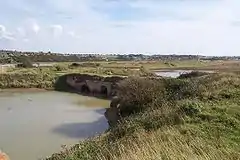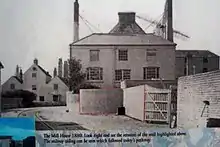Tide Mills, East Sussex
Tide Mills is a derelict village in East Sussex, England. It lies about two kilometres (1.2 miles) south-east of Newhaven and four kilometres (2.5 miles) north-west of Seaford and is near both Bishopstone and East Blatchington. The village was condemned as unfit for habitation in 1936 and abandoned in 1939.
| Tide Mills | |
|---|---|
 The derelict mill race sluice, from the seaward side | |
 Tide Mills Location within East Sussex | |
| OS grid reference | TQ459002 |
| • London | 50 miles (80 km) N |
| Civil parish | |
| District | |
| Shire county | |
| Region | |
| Country | England |
| Sovereign state | United Kingdom |
| Police | Sussex |
| Fire | East Sussex |
| Ambulance | South East Coast |
| UK Parliament | |

History
Thomas Pelham, the politician and prime minister who also held the title Duke of Newcastle, owned land at Bishopstone, and obtained an Act of Parliament which allowed him to use the foreshore of this land for the site of a tide mill.[1] Construction began in 1761,[2] but Pelham died in 1768, and it was not completed until 1788. Three years later, it was advertised for sale in the Sussex Weekly Advertiser, and at the time contained five pairs of mill stones, which could produce 130 quarters (1.65 tonnes) of wheat each week. The exposed location was often a problem, and in 1792 large quantities of flour and wheat were destroyed when the site was hit by a violent storm.[1]
Thomas Barton bought the mill site, and embarked on a series of improvements to make the mill more efficient. He constructed a new three-storey mill building, to house 16 pairs of stones, with which he was able to produce 1,500 sacks (190 tonnes) of flour per week. Ownership changed as a series of partnerships were created and then dissolved. Barton was in partnership with Edmund Catt just prior to 1800, but the London Gazette in 1801 announced that the agreement was no longer in place. Catt then entered into an agreement with his cousin William Catt (1770–1853), but William dissolved this in 1807. William Catt was part of a family who had many farming and milling interests in Robertsbridge and Buxted, and was a keen businessman. He managed the mill well, and it became very profitable, despite the occasional storm damage, such as that in 1820 which damaged the mill building, and washed away some of the mill dam.[3]
According to the census data from 1851, there were 60 men working at the mill, and most of them lived in cottages which Catt had built around the site. He also built a school to educate the children, and although the conditions were rather rudimentary, a thriving community developed. The workers appreciated the facilities provided for their families, at a time when such provision was not common. After the railway line from Newhaven to Seaford was opened, a siding was constructed, which ran between the cottages, enabling large quantities of flour to be transported to Newhaven, from where much of it was shipped to London by sea.[4]
The mill stopped in around 1900 and the village was condemned as unfit for habitation in 1936, with the last residents forcibly removed in 1939.[5] The area was in part cleared to give fields of fire and also used for street fighting training. The site was not used for target practice by Newhaven Fort Artillery, though this story is common locally. The area accommodated vast numbers of Canadian troops during the Second World War.
There are the remains of a station[6][7] on the Newhaven to Seaford line at grid reference TQ460003. It started life as either Bishopstone Station (the Victorian OS map of 1874 shows it as this together with a short branch line to the mills)[8] or Tide Mills Halt, but became Bishopstone Beach Halt in 1939 before its closure in 1942. This is different from today's Bishopstone railway station at grid reference TV469998.
The Sussex Archaeological Society[9] started a long-term project in April 2006 to record the entire East Beach site: Mills, Railway Station, Nurses Home, Hospital, RNAS Station and the later holiday homes and the Marconi Radio station (1904). Apart from the dig, it will evolve into a large collection of film, video, recollections and photographs logging the decline of the area.
Mill complex

Old photographs and paintings, together with a poem, show that the tide mill complex included a windmill.[10]
Access
Access is via either Mill Drove, an insignificant single-track road that runs south-west from the Newhaven and Seaford roads at approximately the point where one changes into the other grid reference TQ463005 (very limited parking, and access is via a pedestrian railway crossing at Bishopstone Beach Halt); or along the beach to the east of Newhaven Harbour.
In popular culture
The Tide Mills features in the 2007 novel A Kind of Vanishing[11] by crime-writer Lesley Thomson. Two girls are playing hide-and-seek in the summer of 1968. Eleanor is hiding from Alice, who never comes looking for her. Alice disappears and more than thirty years later she is still missing. Much of the "action" takes place around the Tide Mills. The cover photograph for the UK edition published by Myriad Editions shows a shot of the Tide Mills.
It also features in a novel of 2018. Set in 1963-4 Change at Tide Mills [12] uses a version of the Mill and village that is still standing. In practice it was demolished in 1940. A family from London revitalises the Mill's fortunes and the main storylines use local landmarks and contemporary values. The Author also offers a talk using contemporary images to flesh out the actual site and surroundings.
See also
- Watermills in the United Kingdom
References
- Stidder & Smith 1997, p. 39.
- "Newhaven Local & Maritime Museum". Newhaven Historical Society. Archived from the original on 5 February 2008.
- Stidder & Smith 1997, pp. 39–40.
- Stidder & Smith 1997, p. 40.
- Hamlyn; Octopus Publishing Group (5 May 2009). Top 10 of Britain. Octopus. p. 29. ISBN 978-0-600-62251-2. Retrieved 16 February 2012.
- "The train now standing at Bishopstone Beach". Sussex Express. Archived from the original on 11 March 2007.
- Bishopstone Beach Halt station
- "Ordnance Survey 1:2500 map". 1874.
- "Bishopstone Tidemills project". Sussex Archaeological Society. Archived from the original on 14 February 2012.
- Source- plaques on the site for visitors
- Thomson, Lesley. A Kind of Vanishing. Myriad Editions. ISBN 978-0-9549309-4-3.
- Wright, Richard Harbroe (2018). Change at Tide Mills. Seaford, UK: Richard Wright. ISBN 9781706113409. Retrieved 12 March 2020.
Bibliography
- Stidder, Derek; Smith, Colin (1997). Watermills of Sussex. Vol 1. Baron Birch. ISBN 978-0-86023-569-9.
External links
![]() Media related to Tide Mills, East Sussex at Wikimedia Commons
Media related to Tide Mills, East Sussex at Wikimedia Commons
- Friends of The Tidemills and Newhaven Eastside Conservation Group
- "Corn. Bishopsten (sic), Sussex. Tide mills. Petition of merchants for sanction to build tide mills for grinding corn". bopcris.ac.uk. Archived from the original on 27 September 2007.
- "Outreach Helps to Turn the Tide". Government News Network. Archived from the original on 10 March 2007.
- Saline Lagoons The pound for the tide mill as a wildlife habitat
- "Tidemills - a sustainable energy story". RiverOcean. Archived from the original on 13 March 2007.
- Abandoned Communities ..... Tide Mills